8.5 /10 2 Votes
Initial release date 8 December 2003 | 9/10 Steam | |||||||||||||||||||||||||||||||||
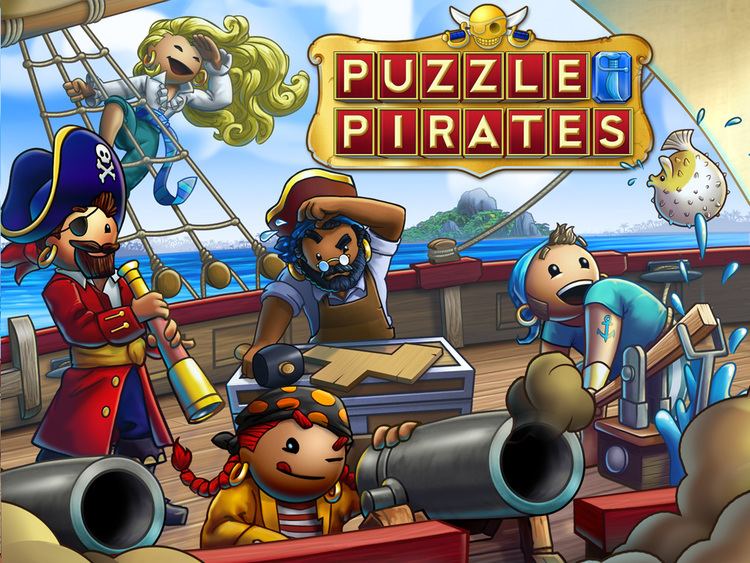 | ||||||||||||||||||||||||||||||||||
Publishers Three Rings Design, Ubisoft Modes Multiplayer video game, Single-player video game (Only with CD) Similar Whirled , Spiral Knights , Bang! Howdy | ||||||||||||||||||||||||||||||||||
Puzzle pirates is still pretty fun a miniscule review
Yohoho! Puzzle Pirates is a massively multiplayer online game developed by Three Rings Design, a company acquired by Sega Sammy Holdings in 2011. The player takes the role of a pirate, adventuring on the high seas and pillaging money ("pieces of eight") from roaming enemy ships (human or computer-controlled). The mechanics of Puzzle Pirates are driven by puzzles. For example, to effectively sail a ship, players must play puzzle games representing work at the sails for speed, pumping bilge water to remove it from the ship, and carpentry to fix any damage the ship may take.
Contents
- Puzzle pirates is still pretty fun a miniscule review
- Puzzle pirates huge sf wagers bum vs tmont
- Oceans and payment methods
- Subscription oceans
- Doubloon oceans
- Family oceans
- Ocean merge
- Grey Havens switchover
- Other language servers
- Puzzle descriptions
- Multiplayer puzzles
- Carousing Puzzles
- Crafting puzzles
- Duty puzzles
- Trophies
- Familiars
- Economy
- Housing
- Crews
- Flags
- Game Gardens
- References
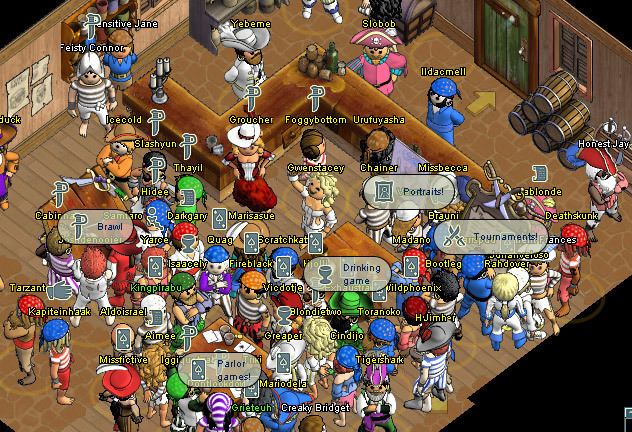
Puzzle Pirates is open-ended and community-driven. Over time, pirates can join a crew, progress in rank within that crew, buy and run sailing vessels and shoppes, and perhaps even become captain of a crew, royalty within a flag (an alliance of crews), or governor of an island. Islands are governed and shoppes are managed exclusively by players. From time to time, players are also called upon to help expand the game, whether it be new puzzles (developed on Game Gardens), island objects to be used on new oceans (servers), or artwork used for a variety of purposes in-game.

Players are encouraged by Three Rings to use pirate-themed words and phrases such as "Yarr!" and "Ahoy there, matey!" instead of "Hi", etc. and Ocean Masters - the moderators of Puzzle Pirates - use these phrases and more. The tips which appear in the game's News, which is updated regularly, use terms such as "Jackanapes". As of December 2008, there are 4 million pirates registered to the game.
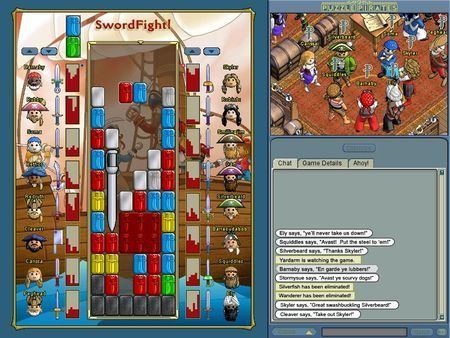
On August 31, 2011, the game was made free-to-play on Steam. Support for an iPad platform was developed and released in 2013. Three Rings later announced the removal of the iPad application and ceased support of the platform in July, 2014.
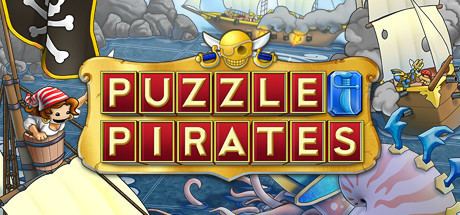
On April 5, 2016, Three Rings Design announced that support of Puzzle Pirates would be no longer be supplied by Three Rings Design, but instead by a company called Grey Havens, who are former Developer(s) of Puzzle Pirates and that the game would maintain support through this new company.
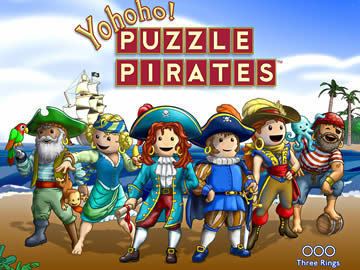
Puzzle pirates huge sf wagers bum vs tmont
Oceans and payment methods

Players are able to play most of Puzzle Pirates for free. Payment methods differ, however, depending on the type of ocean. If playing on a doubloon ocean, one will have to pay doubloons as well as PoE (Pieces of Eight, the primary form of currency used in-game.) On subscription oceans one only requires Pieces of Eight for in-game purchases. For example: a present may cost 5 doubloons and 5,000 PoE on a doubloon ocean but only 5,000 PoE on a subscription ocean.
Subscription oceans
The first subscription ocean opened on December 8, 2003, the official launch date of the game. Subscriber oceans are named after different shades of blue - the ocean that follows the subscription method of payment is known as Cerulean.
Subscription oceans cost US$9.95 per month, with discounts for long term purchases and old accounts. Free (unpaid) accounts have limits, however, such as restrictions on fancy clothing and "high-end" weapons, as well as the inability to perform certain functions reserved for higher pirate ranks.
An alternative method is to convert 42 doubloons into a month's subscription, known as a coinscription, which must be manually renewed each month. In May 2005, the game became available in retail stores, which includes a single month of play as part of the purchase price and a single-player mode where four puzzles may be practiced.
Doubloons do not exist at all on subscription oceans.
There is a test ocean known as Ice which is available to all players who are either current subscribers or have recently purchased doubloons. Though it is a test ocean, it follows the subscription ocean model (paid subscribers have unrestricted access to all parts of the game).
Doubloon oceans
On February 11, 2005, the first doubloon ocean was opened. Doubloon oceans are named after shades of green; the current oceans are known as Meridian, Emerald, Opal (German-language), and Jade (Spanish-language).
On a doubloon ocean, items are purchased both with normal in-game currency (pieces of eight, abbreviated PoE) and a micropayment currency called doubloons. One must spend doubloons to execute the privileges of pirate/officer/captain rank, play most games without restriction, purchase most in-game items (such as boats, clothes, and weapons), create a new crew or flag, and perform other important tasks. As of December 2005, doubloons can be purchased for US$0.20 to US$0.25 each (depending on quantity) or from other players for in-game PoE.
Those willing to pay extra real world cash for extra in-game money can buy many doubloons and sell them to other players for PoE. Those who wish to play for free can purchase the doubloons they want from those players who buy doubloons with cash. Such exchanges are usually done through the in-game doubloon exchange. This works like a commodity exchange marketplace, with a list of buy and sell offers; players can either post an order to wait, or fill the current best order. This effectively creates a pay-as-you-go model, where one can pay with either real world cash or both time and puzzle skills. The extra game-money does not translate directly into game-power; puzzle skills, and organizational skills are far more important than game money.
Doubloons can also be purchased in selected countries by reverse SMS billing, however, as charges are billed in foreign currencies, prices are often substantially higher than payment with a credit card or PayPal. Converting 42 doubloons into a month of subscription permits people who only have access to a mobile phone to play as subscribers.
You may spend $200 or the equivalent in pound sterling a month.
Family oceans
On July 1, 2009 Three Rings released "family oceans" as an experiment. The first, and only Ocean was the Crimson Ocean.
In this ocean, several features which are considered inappropriate or unwanted for children are disabled, including poker, hearts, spades, sinking, etc. It also has a chat filter which only allows words on an approved list of words to be spoken. The Crimson server was shut down permanently on March 31, 2011.
Ocean merge
On December 8, 2011, the developers of Three Rings Design announced that the six English-speaking oceans would be merging into three oceans, with testing which began in early January 2012. The three new oceans would be named as follows;
The merge was made official on January 31, 2012. A few last minute bugs made some bugfix updates necessary, but the new oceans were quickly stabilized.
Grey Havens switchover
On April 5, 2016, Three Rings Design announced support of the game would no longer be provided by them but by Grey Havens. The servers were unavailable for several hours in the early hours of April 5, 2016 PDT to facilitate the switch over. The servers came back up and the game continued as if nothing had happened.
Other language servers
Three Rings Design offered an exclusive license to Gamigo, an online game company based in Germany to host a German language server named the Indigo Ocean. Due to undisclosed issues with Gamigo, Three Rings Design ceased support for the Indigo Ocean. They launched their own German-language server named the Opal Ocean on December 8, 2006, and the Indigo Ocean closed on December 30, 2006.
Announced to the Puzzle Pirate community on May 7, 2008, Three Rings has entered into an agreement with GungHo Online Entertainment Inc. to host a Japanese language server. The new ocean has gone live, but players with accounts on Three Rings' servers cannot play on GungHo's server without signing up with (and paying) GungHo separately.
Three Rings launched a Spanish-language server, the Jade Ocean, in June 2009.
Puzzle descriptions
Many of the puzzles featured in Yohoho! Puzzle Pirates bear resemblances to established puzzle games, with some changes in mechanics. The following list describes each puzzle game, as well as the game(s), if applicable, each was derived from.
Multiplayer puzzles
Interpersonal puzzles can be played between two or more players, and may be wagered on. Swordfighting and Rumbling are also played during a Sea Battle (against computer-controlled Brigands and Barbarians, respectively). Tournaments, funded by players and seeded by the software, are available and commonly played; only Drinking, Swordfighting, and Treasure Drop were playable in tournaments until July 2005. Rumbling was added in April 2006.
Carousing Puzzles
The introduction of Spades in November 2004 heralded the beginning of a new sub-category of competitive multiplayer puzzles classed as parlor games (later known as Carousing Puzzles). Played primarily at inns, these games traditionally include various card games, yet player versus player brawling and drinking is accessible via inns located on most islands.
Crafting puzzles
Six games exist that simulate production of goods. Shop owners and employees play these games to create the goods other pirates have ordered from the associated shops and stalls. So far, only five types of shops have puzzles associated with them as of March 2010: distilleries, apothecaries, shipyards, iron mongers and weaveries. The sixth game, foraging, is played from aboard a ship docked at an uninhabited island; ship owners can pay crew and jobbers to forage for them. Performance on non-existent craft puzzles is simulated.
On subscription oceans, each account receives 24 "hours" of labor per ocean each day, split evenly among multiple pirates on the same ocean. On Doubloon Oceans, each pirate (avatar) may hold a Labor Badge to receive 24 hours of labor per day or a Deluxe Labor badge to receive 72 hours of labor per day, giving a potential 216 hours of labor per day per account. One completed crafting puzzle uses one hour of labor, and each crafted good requires a certain number of hours of labor to be completed. Once a pirate's allotment of hours is used up, that pirate cannot contribute to the production of goods until the next day (although the puzzle can still be played, for practice). Pirates who have jobs can contribute their labor to a shop without playing the puzzle, although they must play occasionally to keep their ratings from going dormant.
There are a few crafting jobs which do not yet have puzzles. They are:
Duty puzzles
A number of puzzles are available only on a ship, and help to maintain that ship and increase its performance while sailing. Many crews insist on their members being well-experienced in these, if not the other, puzzles before promoting them to higher positions.
Trophies
Trophies are special rewards given to pirates for exceptional achievements. They can be displayed on pirate info pages (where they can choose a maximum of six trophies to display on their front page) and in a gallery, similar to portrait galleries. Trophies are permanent, so they cannot be traded between pirates or taken away when the circumstances with which they were awarded change (e.g. if a pirate later loses their ultimate standing, that pirate still has the trophy). However, trophies awarded due to bugs in the game have sometimes been revoked. Thus, if a player earned the Ultimate Crafter trophy before the existence of Blacksmithing, they will keep the Ultimate Crafter trophy. Pirates who did not have the Ultimate Crafter trophy before Blacksmithing was added to the game must now earn the Ultimate Blacksmithing trophy in order to earn Ultimate Crafter. Those with all Ultimate trophies gain the Ultimate of Ultimates trophy.
Another example is the incredible trophies, awarded when a player gets an incredible duty report while on a pillage or with the navy. There are trophies if a pirate plays on a certain puzzle for a certain amount time, or experience. Other trophies can be for random things, like being on a sinking ship or being in a certain number of battles where there was no rum on the ship. Atlantis has its own set of trophies, for sinking certain creatures or winning sword fights while in Atlantis. There are also foraging trophies, awarded when a player finds gold a certain number of times while foraging, and festive trophies, given out depending on the certain time of year, like Halloween and Christmas competition trophies.
Familiars
Familiars are small animals that may perch on a pirate's shoulder, even if a pet is with the pirate. They can be won in tournaments, sea monster hunts, or by random chance from boxes. There are many types of familiars, including dragon, monkey, snake, parrot, and ippolito. Skeletal monkeys are found by buying a black box from a black market. An annual familiar is available from each generation of gold boxes. Past and current annual familiars include dragons, toucans, and chameleons.
Economy
Puzzle Pirates features a market economy. Basic resources, such as wood and iron, as well as various herbs and minerals are produced by the game on most islands. Most colonized islands and some uncolonized islands have markets, which sell the local production to the highest bidder; others are harvested by "Merchants" which in turn sail the goods to the highest dockside buy offer (taking cost of delivery and distance into account). On uninhabited islands, players may harvest fruit, and may sell them to either the government of other islands (if the government is buying those fruits) or privately owned businesses. Commodities are processed by player-run shops, using player-supplied labor, into refined goods such as swords, ships and rum, or into intermediate items such as cloth or enamel.
Unlike most MMOGs, player-run shops and stalls determine what will be made at what price, with player employees that are hired to help with the crafting. While anyone can open a stall (full sized shops require an island governor to grant land), there is both an opening cost, as well as the need to acquire the commodities to construct the product, and the labor and time to actually construct. In addition, there is a weekly tax which is paid out of the shoppe or stall. Tax amounts depend on the size of your stall, as well as an additional rate set by the governor. This is very different from crafting in other games, where any individual player may gather the materials and craft any item, usually instantly once you have the materials, without needing to own a shop or hire help. The best way to think about this is simple: The person who opens and runs a shop is not the crafter; they are the manager of an industrial production shop. However, managers can become employees of their own shops and input to the labor needed to make the product.
To keep an ocean's economy going, most items age. When a certain amount of time passes, the item will have "aged" and it "crumbles to dust", disappearing completely. As an exception, tops and pants turn into rags if you have no other clothing of that type, and swords will turn into a stick if you have no other sword. Sticks do not age, although rags do. To sell a stick, you must have another sword besides a stick.(Few people in the general market will actually buy a stick.) The conditions, in order from newest to oldest is: New, good, old.
With the exception of ships, which may be sunk in only certain circumstances, all items manufactured by players in Puzzle Pirates either decay or are consumed in everyday use. Cannonballs are shot during battle, rum is drunk during voyages, swords, mugs and clothes decay through wear-and-tear, and furniture wears out when it is moved around to redecorate scenes (generally housing rooms and ship decks). This decay results in a steady demand for new items. Specifically, it forces on-going demand for raw commodities and player crafting labor, keeping shops in business. Without this, the eventual oversupply of finished items would result in "worthless game coin", as finished items are extremely common, and game coin has no meaning.
Housing
There are 11 houses available for purchase. Each player receives a free shack (one room) the first time they play, and are also given a crate and bedroll (both furniture) and free pet rat. Each house has a varying number of room-mates, who are free to move furniture, access the building while the owner is away, and access treasure chests and wardrobes within the building. The exact number depends on the size of the house. The price of housing increases as the number of roommates and available space is increased. Furnishings may be purchased in furniture shoppes around the islands. Pirate halls are also available in multiple sizes to accommodate crews and flags.
Crews
Crews are the central artery in Puzzle Pirates. The purposes of crews vary widely but the general purpose is for the crew to acquire fame, create a good social atmosphere, and join or create a flag. The following are the ranks that one may have within a crew. (Note that the requirements for achieving certain ranks differs with each crew, and that ranks are assigned by the captain or by a vote, depending on the crew's political system.)
To start a crew, a pirate must have achieved narrow experience in bilging, sailing, carpentry, sword fighting, navigation and battle navigation and any other piracy skills, own a deed to a ship, and have a captain's badge and ten doubloons on doubloon oceans or be a subscriber on subscriber oceans.
Flags
Flags are groups of crews that join together. Flags are the groups that go to war and form alliances, not the individual crews. There are three "ranks" in flags:
Monarch are given the title "King" or "Queen", royalty are titled "Prince" or "Princess", and titled members either "Lord" or "Lady".
When a flag proposes an alliance, truce, or war, it is voted on by the monarch and royalty. The monarch and royalty are also the only people who can propose problems for voting.
In order to start a flag, a crew must have an Established or higher fame and a person must have both a captain's badge and 20 doubloons on doubloon oceans or be subscribed on subscriber oceans.
Game Gardens
Three Rings Design has also created a site called Game Gardens, which hosts no fee tools for creating and playing Java games. Using the toolset requires knowledge of Java, but the toolset automates many basic game-related functions. Some Puzzle Pirates players use it to create demonstrations of new puzzle ideas for the game; because the tools are the same as those the designers use, importing a Game Gardens puzzle into Puzzle Pirates would not be difficult.
